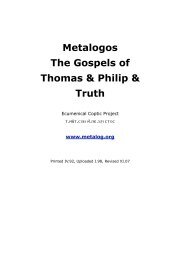Gospels of Thomas and Philip and Truth - Syriac Christian Church
Gospels of Thomas and Philip and Truth - Syriac Christian Church
Gospels of Thomas and Philip and Truth - Syriac Christian Church
You also want an ePaper? Increase the reach of your titles
YUMPU automatically turns print PDFs into web optimized ePapers that Google loves.
sacrament <strong>of</strong> bread <strong>and</strong> wine; see Sacrament (Lk 22:1420).<br />
Eve (76): Heb hwx (living; Gen 3:20); see Cain <strong>and</strong> Female.<br />
Expectation (122): Gk ΕΛΠΙΣ = Heb hwqt (tiqvah); not mere hoping or wishing,<br />
but rather anticipation— Clement <strong>of</strong> Alex<strong>and</strong>ria, Stromata II.6: ‘Hope is the<br />
expectation <strong>of</strong> the possession <strong>of</strong> good; necessarily, then, is expectation founded on<br />
faith’; Isa 42:9, Jn 16:13!<br />
Female (18): Copt s6ime (C385a); here emphasizing the Sacred Spirit as our<br />
Mother, as in Isa 49:15 66:13, Lk 13:34; see Spirit <strong>and</strong> ‘The Maternal Spirit’.<br />
Hebrew (1 6 18 50): Heb rb( (eber: cross over, beyond, passer-by, transient;<br />
Th 42!); the lineage <strong>of</strong> Shem <strong>and</strong> especially <strong>of</strong> Abraham (Gen 10:21 14:13 16:15—<br />
thus Ishmael also was a Hebrew).<br />
Heir (98): Copt 2ro2 (C831b: seed, sperm); in light <strong>of</strong> Ph 18, <strong>and</strong> as with Gk<br />
ΣΠΕΡΜΑ in Ph 108, this term must here be a metaphor for ‘heir’ rather than<br />
meaning literally ‘progeny’.<br />
Image/Imagery (24 26 30 47 72 84 93 95 130 136 143): see Th Notes.<br />
Inequality (65): Copt at.twt (P063d C438a: not in agreement, not conjoined);<br />
see Conjoin <strong>and</strong> Th 61b!<br />
Ionian (20): Gk ΙΟΝΙΟΣ (violet) = Heb Nyy/Nwy (yayin/yavan: wine); Hebrew name<br />
for the Greeks (Gen 10:2-5, Dan 8:21); the coast <strong>of</strong> Asia Minor (now Turkey) was<br />
where Greeks met the ancient middle-eastern civilizations, acquiring the alphabet<br />
via the Semitic-speaking Phoenicians (ΦΟΙΝΙΞ: purple— Gk name for the<br />
Canaanites [Heb: ‘merchants’] <strong>of</strong> Gen 9:18-10:19 12:5-7, IKi 5, Ezek 27-28; cp. Mt<br />
15:22 with Mk 7:26; according to Herodotus' Histories I, Thales <strong>of</strong> Miletus— the first<br />
‘pre-Socratic’— was a Phoenician/Canaanite).<br />
Jerusalem (82): Heb Myl#wry (foundations/city <strong>of</strong> peace); note that Heb hry<br />
(yarah: directive) is the root <strong>of</strong> both ‘Jeru-’ <strong>and</strong> ‘Torah’.<br />
Jordan (88): Heb Ndry (descender); the river <strong>of</strong> the Holy L<strong>and</strong>, in the northern<br />
extension <strong>of</strong> Africa's Great Rift Valley; NB apparently the River Pishon <strong>of</strong> Gen<br />
2:11(!); thus, could the Flood have swept down thru the Jordan Rift Valley?!—<br />
topologically more intelligible, except for the puzzling Ararat (which, however, means<br />
merely ‘sacred/high l<strong>and</strong>’); this would <strong>of</strong> course place all <strong>of</strong> Gen 2-9 in the Jordan<br />
Valley, with Gen 10 the first human (i.e. linguistic?!) dispersion, <strong>and</strong> Gen 11<br />
88




